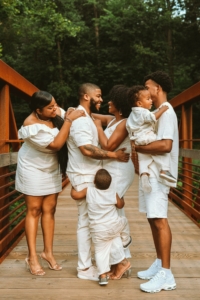Dating with a Purpose: Praying and Planning for Relational Success
 Few decisions in our lives shoulder the weight of success or sabotage like matters of the heart. While our choice to follow Christ is the most significant choice that impacts all others, who we link with in dating or in marriage, polarizes our path. It either fuels us in fulfilling God’s purpose for our lives or frustrates us in walking toward destiny.
Few decisions in our lives shoulder the weight of success or sabotage like matters of the heart. While our choice to follow Christ is the most significant choice that impacts all others, who we link with in dating or in marriage, polarizes our path. It either fuels us in fulfilling God’s purpose for our lives or frustrates us in walking toward destiny.
Our hearts cannot always be trusted to make the wisest decisions and they often become obsessed with external appearances or are tempted by sin. God has given us wisdom in His word to help us make healthy and wise decisions. The Bible equips us to live a godly life (2 Peter 1:3). The Lord created us and knows our beginning and our end. He has given us all we need in His word.
Since we don’t automatically know the wisest course of action, we require the wisdom of the Holy Spirit. As we seek a marriage partner to be part of our life, we must pray and plan and seek God’s kingdom and His righteousness. Newport Beach Christian Counseling offers faith-based guidance to help individuals navigate relationships with wisdom, prayer, and a Christ-centered perspective.
Pray purposefully
God speaks to us through His written word and illuminates what seems obscure or confusing (John 10:27-30). God’s Word tells us how to communicate with Him, and it clarifies and confirms His guidance. When we are single, and ideally undistracted, we can embrace our singlehood for purposeful prayer, asking God to bring the right person to us in His perfect timing.
Praying with a purpose allows us to grow in intimacy with the Lord. He already knows what we think and how we feel. Sharing our real experiences and emotions, then surrendering them to Him allows us to become more confident and better able to hear His voice speaking through His word. Submitting to the Word and His commands empowers us to actively resist the enemy’s influence (James 4:7).
Plan intentionally for dating
 God, who is Beginning and End, has ordained our life to reflect His glory on earth (Revelation 1:8). He wants you to see the wonder of His image in you. As you pray, ask Him to harmonize your ideas and plans with His. Pay attention to the wisdom of the Scriptures as you form plans and goals that maximize your gifts and align with His purpose.
God, who is Beginning and End, has ordained our life to reflect His glory on earth (Revelation 1:8). He wants you to see the wonder of His image in you. As you pray, ask Him to harmonize your ideas and plans with His. Pay attention to the wisdom of the Scriptures as you form plans and goals that maximize your gifts and align with His purpose.
Process authentically
We tend to view our pain through a lens of shame, but God can heal the unresolved pain that we hide. Participating in a process to work through past issues often hurts before we feel the effects of healing.
That involves offering our wounds to Him with open hands and a surrendered heart. His supernatural strength targets and triages our weaknesses. He beckons us to approach Him boldly, and He responds by lavishing us with fresh mercy and grace (Hebrews 4:16).
Awareness and acknowledgment
Only the searchlight of the Holy Spirit can bring awareness of the hidden parts of our hearts. Is there repeated sin poisoning us from the inside out? We often become numb to it, unaware that we are partnering with forces that oppose our faith (Ephesians 6:10-12).
When we are seeking dating relationships that lead to marriage, we need to be aware of negative mindsets that influence our behavioral patterns. Dysfunctional cycles surface, circulating the issues that have disrupted our progress and success with relationships.
Ask the Holy Spirit to highlight where these offenders entered, even if they have lingered through your family’s generations. God champions your future marriage. Working through issues while unmarried reflects an active partnership with the One who authors your destiny. As you return to Him, repentance welcomes healing and deliverance, bringing the freedom to connect from a whole and healthy heart.
If we confess our sins, he is faithful and just and will forgive us our sins and purify us from all unrighteousness. – 1 John 1:9, NIV
Addressing the issues in dating

Beyond the sin factor, our mates weren’t meant to carry every emotional load. When we avoid attending to heart matters while single, we place undue expectations and weight on our future marriages.
As the Holy Spirit reveals “thorns” or areas of weakness, He also furnishes God’s grace and practical remedies that transform us (2 Corinthians 12:9). Wisely using the gift of the present affords us the space and strength to prepare with God, and perhaps a counselor, to work on matters that may make us better dating partners and spouses.
Aligning hearts
We are not serving ourselves or our future spouses well when we short-circuit necessary steps for repentance and faith. Although physique and chemistry play a key role in attraction, cultivating spiritual, mental, and emotional development affects the longevity of a connection.
We mask our real selves with illusions like Adam and Eve who fashioned clothing from fig leaves. As clever as they may have thought themselves, the cover betrayed their sinful hearts. Not only do we want to present our real selves to potential spouses, but we must get right with God first.
Allied and agreed in dating
Scripture causes us to reflect on the importance of alliances. Every believer’s walk with the Lord is unique, so every potential partner might not be in the same spiritual place.
 However, walking in agreement, that is aligned with Jesus and not in step with the world, is foundational to establishing a dating partnership and eventual marriage. While the external person initially attracts, the internal is integral to what nurtures a marital covenant over the long term.
However, walking in agreement, that is aligned with Jesus and not in step with the world, is foundational to establishing a dating partnership and eventual marriage. While the external person initially attracts, the internal is integral to what nurtures a marital covenant over the long term.
Being equally yoked is often mentioned in single circles, but it is more than sharing a set of morals. Our core values, gifts, goals, and purpose factor into our suitability as a mate. We need counsel from the Holy Spirit, other mature believers, and perhaps a trained professional.
From these places of contemplation, we can develop questions and form criteria to gauge whether we will advance our dating relationships. God doesn’t move accidentally, and following Him will enable us to act with intention.
Do not be mismatched with unbelievers; for what do righteousness and lawlessness share together, or what does light have in common with darkness? – 2 Corinthians 6:14, NASB2020
Next steps for dating
Let’s use our singleness to nurture our first marriage with Christ, our Bridegroom. We, as the Church, inclusive of male and female believers, are joined to Him in one Body, much like the illustration of two becoming one woven throughout the Scriptures.
In the natural and spiritual, we can pray, plan, and process to become a better fit for our potential mate, but even more so, for our King of Kings. As we communicate with the One who inspired and authored Scripture, He aligns us with His own Heart and prepares us to walk in agreement with a partner.
While you cannot control the timing for encountering dating partners and potential spouses, you can influence your preparation. God has outfitted you with resources. Avail yourself of the options for counseling at Newport Beach Christian Counseling. Locate the support and sustained care that will make you ready to recognize and receive what awaits as you pray, plan, and prepare for adventures with God.
“Couple on a Bench”, Courtesy of Evan Tang, Unsplash.com, CC0 License; “Coffee Date”, Courtesy of DocuSign, Unsplash.com, CC0 License; “Breakfast Together”, Courtesy of Getty Images, Unsplash.com, Unsplash+ License; “Happy Couple”, Courtesy of Tim Mossholder, Unsplash.com, CC0 License

 Sometimes you find yourself in the middle of bringing together two families. For whatever reason, you are now navigating a home life with a mixture of feelings and habits. What seems like an angry child could be a child who is scared of losing everything that was comforting to them. Creating a home for a blended family takes patience and grace.
Sometimes you find yourself in the middle of bringing together two families. For whatever reason, you are now navigating a home life with a mixture of feelings and habits. What seems like an angry child could be a child who is scared of losing everything that was comforting to them. Creating a home for a blended family takes patience and grace.  some life-changing events it isn’t always easy for them. They still have to learn to navigate the change in the best way they can. Losing a parent is traumatic for children. Whether it is by divorce or death, not having that parent in their everyday life can cause lasting emotional problems.
some life-changing events it isn’t always easy for them. They still have to learn to navigate the change in the best way they can. Losing a parent is traumatic for children. Whether it is by divorce or death, not having that parent in their everyday life can cause lasting emotional problems.
 Relationship changes. When children find themselves in a new relationship, they may seem distant and reserved. The changes in the family will bring changes in the roles of each person. A child who was the youngest may now find themselves as being the oldest.
Relationship changes. When children find themselves in a new relationship, they may seem distant and reserved. The changes in the family will bring changes in the roles of each person. A child who was the youngest may now find themselves as being the oldest.